McCabe, Edward James (Flying Officer)
Killed in Flying Accident 1945-July-24


Birth Date: 1924
Born:
Parents: Son of John Joseph and Mary Meagher McCabe, of Toronto, Ontario.
Spouse:
Home: Toronto, Ontario
Enlistment:
Enlistment Date: unkown date
Service
RCAF
Unit
441 Sqn- Squadron
Stalk and Kill
Base
Rank
Flying Officer
Position
Pilot
Service Numbers
J/43858
Prev: R/206147
Home
Crew or Other Personnel
Mustang KH569
Mustang serial: KH569
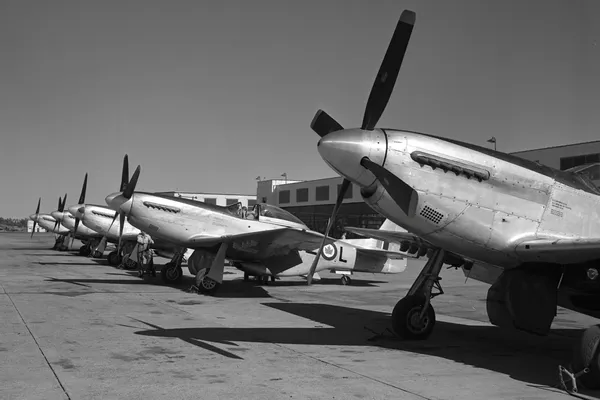
North American Mustang Mk. IV, RCAF (Serial No. 9253), coded BA-S,
No. 424 Squadron, Hamilton, Ontario
Chris Charland noted that the Mustang in the forefront is former USAF P-51D (Serial No. 44-74502A).
The North American Aviation P-51 Mustang is an American long-range, single-seat fighter and fighter-bomber used during World War II and the Korean War, among other conflicts. The Mustang was designed in April 1940 by a team headed by James Kindelberger of North American Aviation (NAA) in response to a requirement of the British Purchasing Commission. The Purchasing Commission approached North American Aviation to build Curtiss P-40 fighters under license for the Royal Air Force (RAF). Rather than build an old design from another company, North American Aviation proposed the design and production of a more modern fighter. The prototype NA-73X airframe was rolled out on 9 September 1940, 102 days after the contract was signed, and first flew on 26 October
The Mustang was designed to use the Allison V-1710 engine, which had limited high-altitude performance in its earlier variants. The aircraft was first flown operationally by the RAF as a tactical-reconnaissance aircraft and fighter-bomber (Mustang Mk I). Replacing the Allison with a Rolls-Royce Merlin resulted in the P-51B/C (Mustang Mk III) model, and transformed the aircraft's performance at altitudes above 15,000 ft (4,600 m) (without sacrificing range), allowing it to compete with the Luftwaffe's fighters. The definitive version, the P-51D, was powered by the Packard V-1650-7, a license-built version of the two-speed, two-stage-supercharged Merlin 66, and was armed with six .50 caliber (12.7 mm) AN/M2 Browning machine guns.
Canada had five squadrons equipped with Mustangs during the Second World War. RCAF Nos. 400, 414 and 430 Squadrons flew Mustang Mk. Is (1942"“1944) and Nos. 441 and 442 Squadrons flew Mustang Mk. IIIs and Mk. IVAs in 1945. Wikipedia and Harold Skaarup web page
Unit Desciption
441 Sqn Stalk and Kill ("Silver Fox")
History of the Squadron before and during World War II (Aircraft: Spitfires of several Mks, Mustang III)
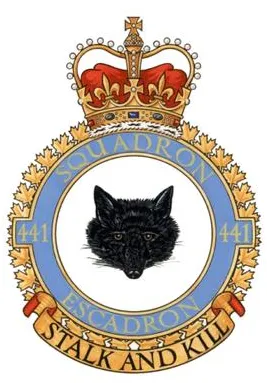
No 441 (F) Squadron was formed in Sydney, NS  as No. 125 (F) Squadron RCAF on 20 April 1942. It flew Hawker Hurricane aircraft on East Coast air defence. It was the fourth of six home squadrons transferred overseas without its aircraft, and was re-designated No. 441 (F) Squadron RCAF at Digby, Lincolnshire, UK
as No. 125 (F) Squadron RCAF on 20 April 1942. It flew Hawker Hurricane aircraft on East Coast air defence. It was the fourth of six home squadrons transferred overseas without its aircraft, and was re-designated No. 441 (F) Squadron RCAF at Digby, Lincolnshire, UK  on February 8 1944. It flew Spitfire aircraft in offensive and defensive operations in the preparation for D-Day, and afterwards gave close support to the ground troops. It moved with the ground troops through France and Belgium, and returned to the UK in October 1944 and flew from various bases there until the end of hostilities in Europe. In May 1945 the squadron was re-equipped with Mustang aircraft, to provide fighter cover for long-range bomber groups, but were never operational in this role. The squadron was disbanded at Molesworth, Huntingdonshire, UK
on February 8 1944. It flew Spitfire aircraft in offensive and defensive operations in the preparation for D-Day, and afterwards gave close support to the ground troops. It moved with the ground troops through France and Belgium, and returned to the UK in October 1944 and flew from various bases there until the end of hostilities in Europe. In May 1945 the squadron was re-equipped with Mustang aircraft, to provide fighter cover for long-range bomber groups, but were never operational in this role. The squadron was disbanded at Molesworth, Huntingdonshire, UK  on August 7, 1945.
on August 7, 1945.
In the course of operations, the squadron flew 3148 sorties for the loss of16 pilots, of whom 2 were killed, 7 presumed dead and 6 POWs. They accounted for 56 enemy aircraft confirmed destroyed and 12 damaged. In ground attacks they were credited with 500-plus vehicles. The squadron had 3 aces: Flight Lieutenant D.H. Kimball, DFC; Flight Lieutenant G.E. Mott, DFC and Flight Lieutenant T.A. Brannigan DFC. The squadron amassed 9 DFCs, 1 Croix de Guerre (France) and 3 MiDs. Battle Honours were: Defence of Britain 1945, Fortress Europe 1944, France and Germany 1944-45, Normandy 1944, Arnhem, Walcheren.Wikipedia, Kostenuk and Griffin
Maps for Movements of 441 Squadron 1944-45
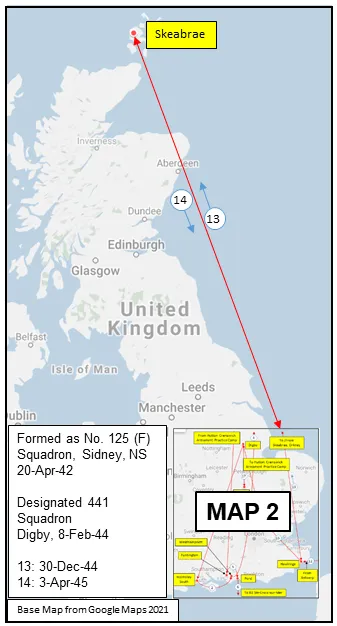
MAP 1: 441 Squadron Movements 1944-45 (right-click on image to display enlarged in new tab)
|

MAP 2: 441 Squadron Movements 1944-45 (Detail of Map 1)
|
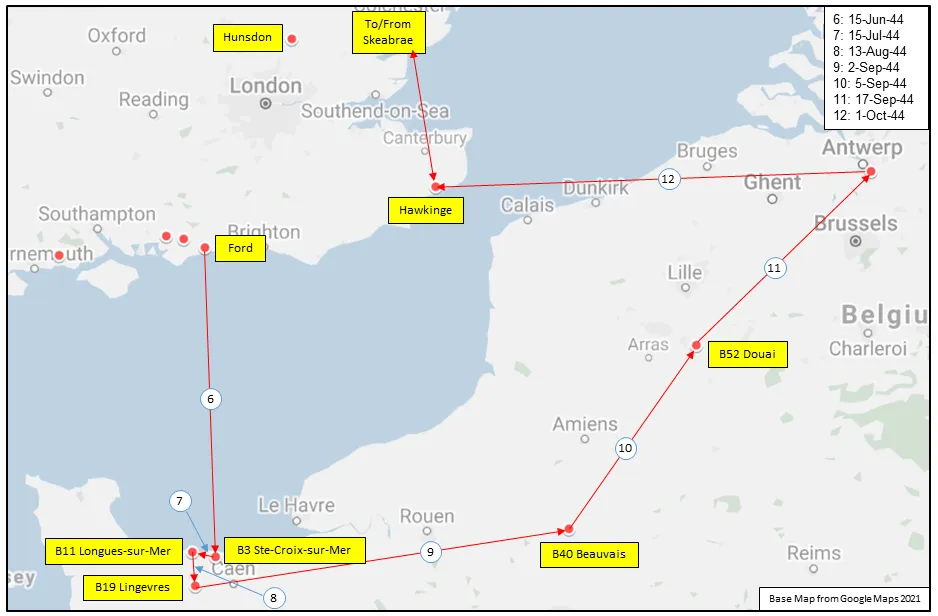
441 Squadron History Summary 1944-45
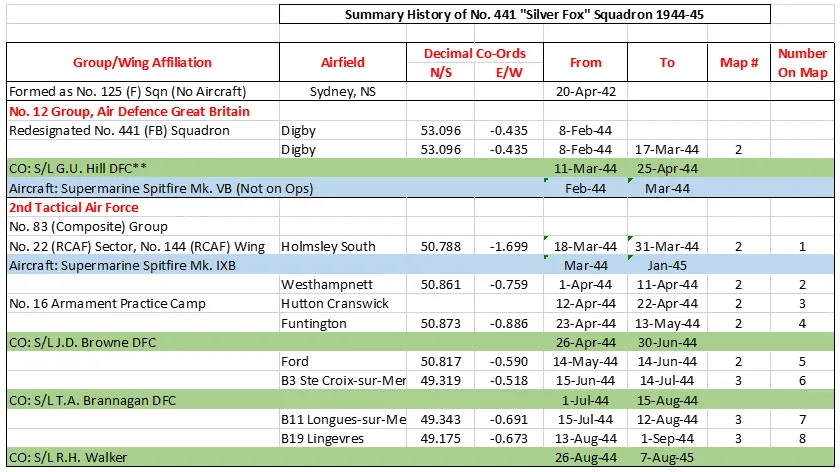
441 Squadron History Summary 1944-45 Page 2
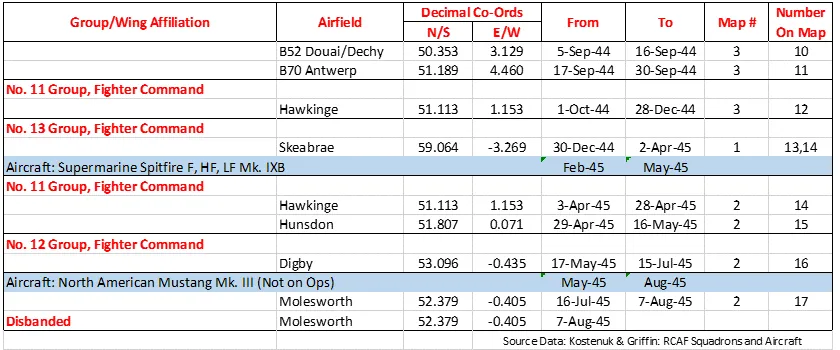
History of the Squadron Post-WWII (Aircraft: Vampire III, Sabre 2, 5, 6, Starfighter, Hornet)
No 441 Squadron reformed at RCAF Station St. Hubert  on 1 March 1951, flying de Havilland Vampire III and later Canadair Sabre Mks. 2, 5 and 6. They joined No 1 (Fighter) Wing, then located at RAF North Luffenham, in Rutland, England
on 1 March 1951, flying de Havilland Vampire III and later Canadair Sabre Mks. 2, 5 and 6. They joined No 1 (Fighter) Wing, then located at RAF North Luffenham, in Rutland, England  on 13 February 1952. The squadron was temporarily situated at 3 Wing Zweibrücken, Germany
on 13 February 1952. The squadron was temporarily situated at 3 Wing Zweibrücken, Germany  on 21 December 1954, before moving to their intended destination, RCAF Station Marville, France
on 21 December 1954, before moving to their intended destination, RCAF Station Marville, France  . It was selected as one of the eight squadrons to be re-equipped with the CF-104 Starfighter, so it was deactivated on 1 September 1963 at Marville and then reactivated (reformed) as No 441 Strike/Attack squadron on 15 September. It then moved with 1 Wing to CFB Lahr, Germany
. It was selected as one of the eight squadrons to be re-equipped with the CF-104 Starfighter, so it was deactivated on 1 September 1963 at Marville and then reactivated (reformed) as No 441 Strike/Attack squadron on 15 September. It then moved with 1 Wing to CFB Lahr, Germany  in April 1967. On 1 February 1968 the squadron was integrated into the Canadian Armed Forces. In 1971 the squadron moved to CFB Baden-Soellingen
in April 1967. On 1 February 1968 the squadron was integrated into the Canadian Armed Forces. In 1971 the squadron moved to CFB Baden-Soellingen  and changed its name to 441 Tactical Fighter Squadron. They disbanded again in 1986 and then finally reformed at 4 Wing Cold Lake, Alberta
and changed its name to 441 Tactical Fighter Squadron. They disbanded again in 1986 and then finally reformed at 4 Wing Cold Lake, Alberta  on 26 June 1986, flying CF-18 Hornet aircraft. The squadron flew mostly close air support and battlefield air interdiction missions over Kosovo and the Federal Republic of Yugoslavia, under Task Force Aviano, 5 Allied Tactical Air Force from 12 April to 10 June 1999.
on 26 June 1986, flying CF-18 Hornet aircraft. The squadron flew mostly close air support and battlefield air interdiction missions over Kosovo and the Federal Republic of Yugoslavia, under Task Force Aviano, 5 Allied Tactical Air Force from 12 April to 10 June 1999.
On 6 July 2006, No 441 Squadron was finally stood down (disbanded), and its crews amalgamated with 416 Tactical Fighter Squadron at CFB Cold Lake and re-formed as 409 Tactical Fighter Squadron. The squadron's colours and battle honours have been placed in Sydney, Nova Scotia, where it first operated.